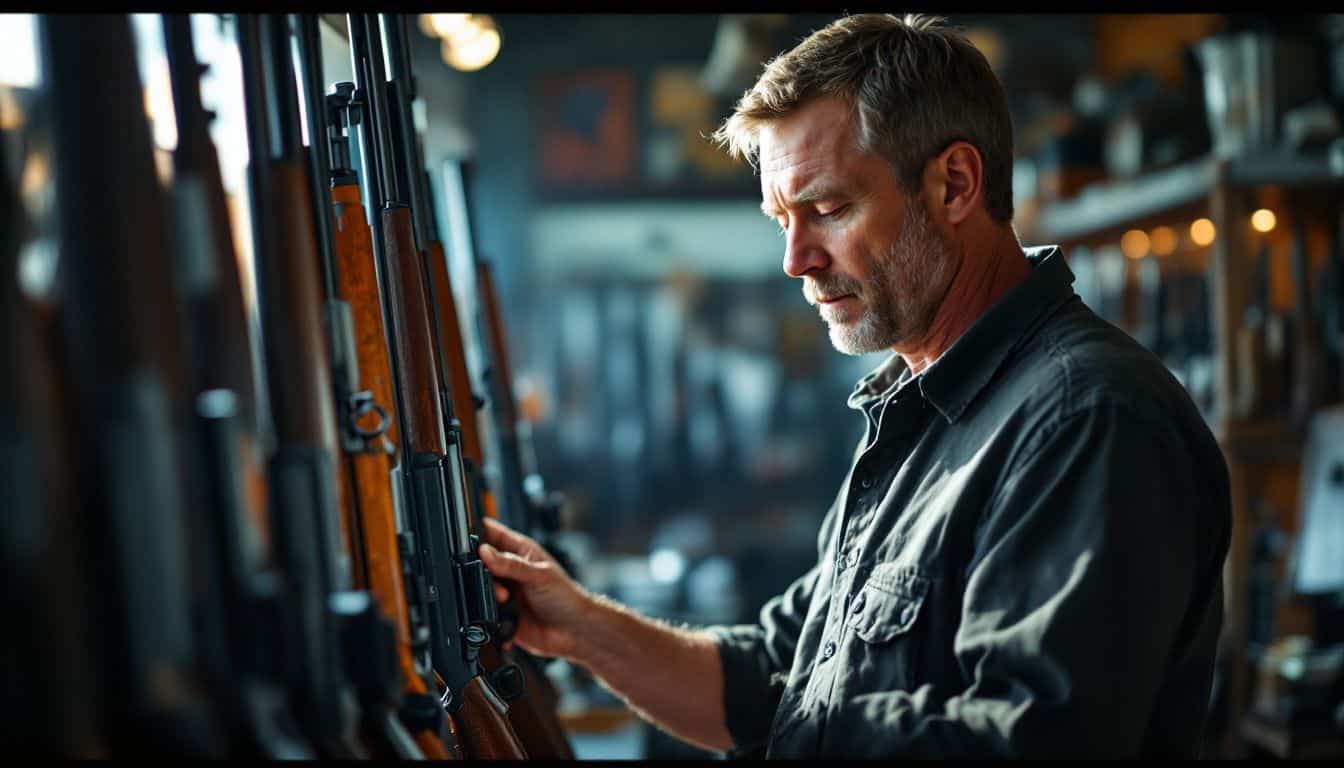Buying a hunting rifle can be overwhelming. What do you need to buy a hunting rifle? It’s a question that stumps many first-timers. Rifles come in various types, from bolt-action to semi-automatic, each with its own perks.
This guide will break down the essentials and help you pick the perfect firearm for your hunting needs. Ready to hit the bullseye?
Key Takeaways
Hunting rifles come in various types, including bolt-action, lever-action, and semi-automatic. Bolt-action rifles are popular for accuracy and dependability.
Choose a rifle caliber based on the game you’ll hunt. Smaller rounds like .243 Winchester work for small game, while larger calibers like .308 Winchester are better for big game.
Optics are crucial. Quality scopes start around $500. A 3-9x40mm scope with BDC reticle is versatile for beginners. Red dot sights offer quick target acquisition.
Background checks are required when buying from licensed dealers. State laws vary, so check local rules before purchasing. You must be 18 or older to buy a rifle.
Essential accessories include cleaning supplies, protective cases, bipods, and slings. Online retailers often offer lower prices (around $800) compared to local gun stores.
Table of Contents
Key Features of Hunting Rifles
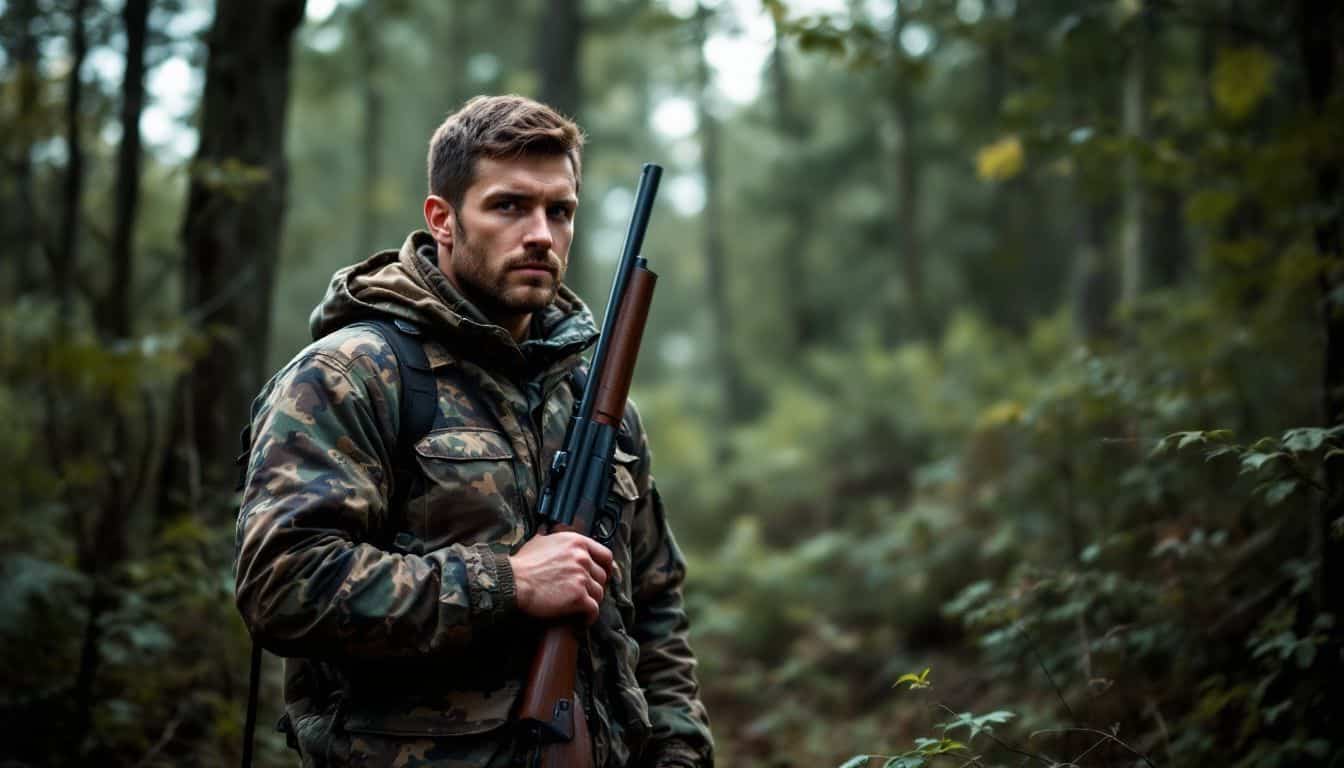
Hunting rifles pack a punch with their key features. From slick bolt actions to hard-hitting calibers, these guns are built to perform in the field.
Types of Rifle Actions
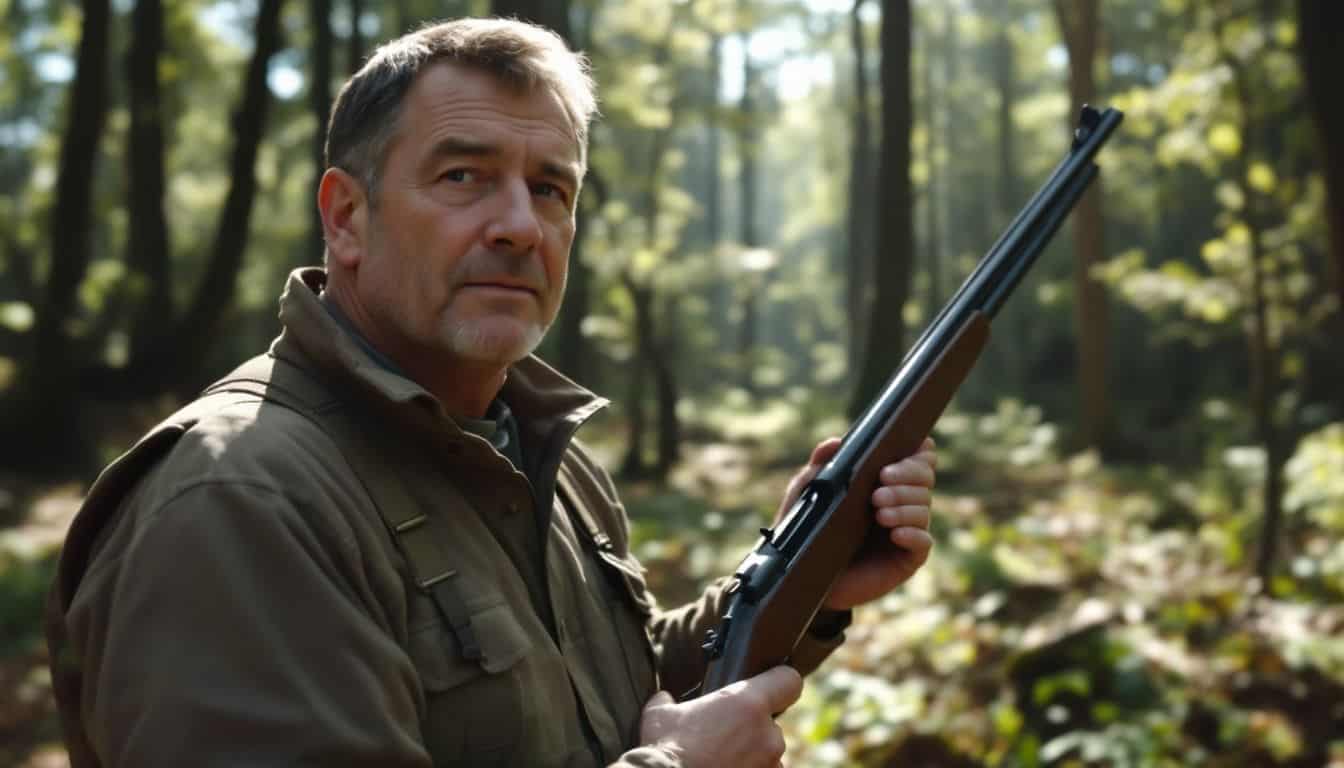
Rifle actions come in different flavors, each with its own perks. Single-shot rifles, like break-action or bolt-action, are simple and reliable. They’re great for learning to shoot and honing your skills.
But if you want more firepower, repeating rifles are your go-to. These include bolt-action, lever-action, pump-action, and semi-automatic models.
Bolt-action rifles are popular for their accuracy and dependability. They’re a top choice for many hunters. Lever-action rifles sport shorter barrels and flat-sided receivers, making them handy in tight spots.
Choose your rifle action like you choose your friends – carefully and based on how well you work together.
Semi-automatic rifles offer the fastest follow-up shots, but they’re more complex. Each type has its strengths, so pick the one that fits your hunting style best.
Barrel Characteristics
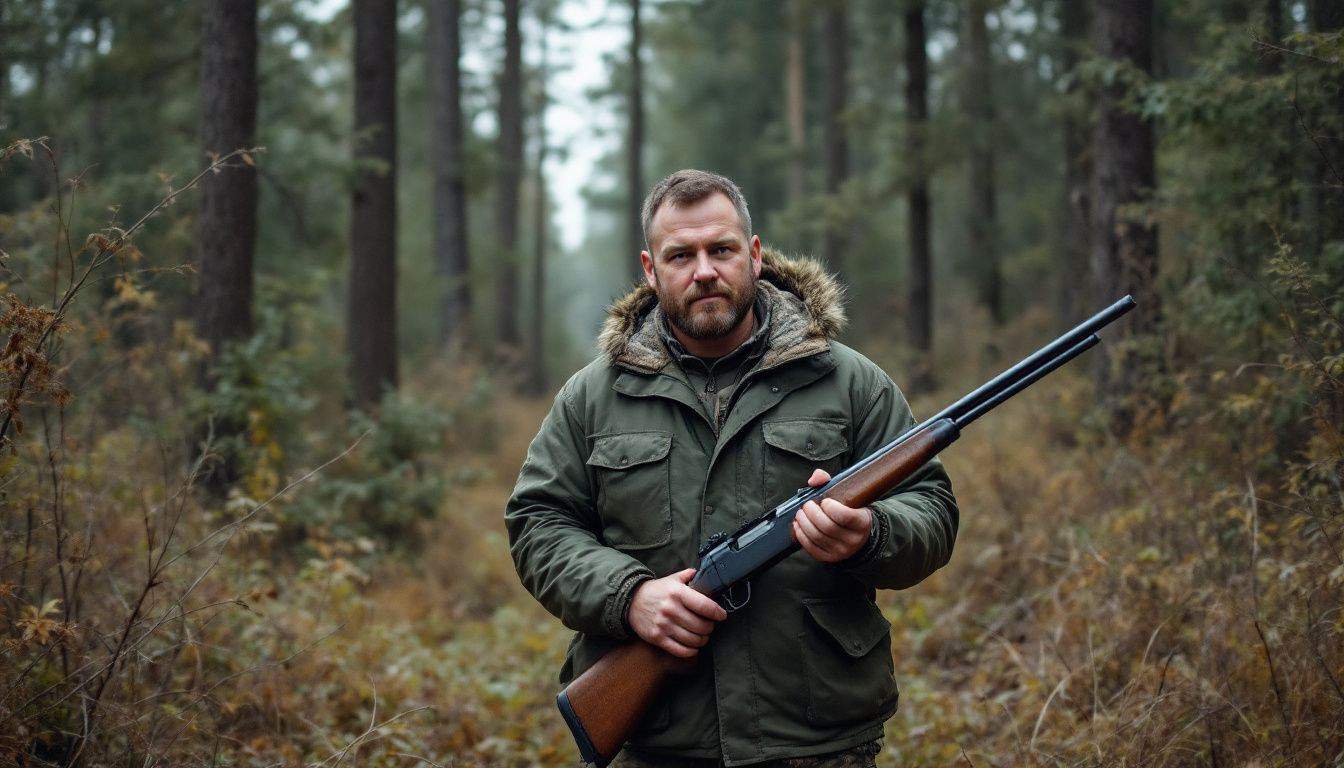
Barrels make or break a hunting rifle. Long barrels boost speed, but they’re heavy. Short ones are light and easy to carry, but bullets fly slower. Most hunters go for a middle ground – about 22 inches.
It’s long enough for good speed, but won’t snag on branches.
Material matters too. Stainless-steel fights rust like a champ. It’s great for wet hunts. Carbon-wrapped steel is new and cool. It’s tough as nails and keeps the barrel from getting too hot.
The shape counts too. Thick barrels are heavy but stay steady. Thin ones are light but heat up fast. Pick what fits your hunting style and budget.
Caliber and Ammunition Types
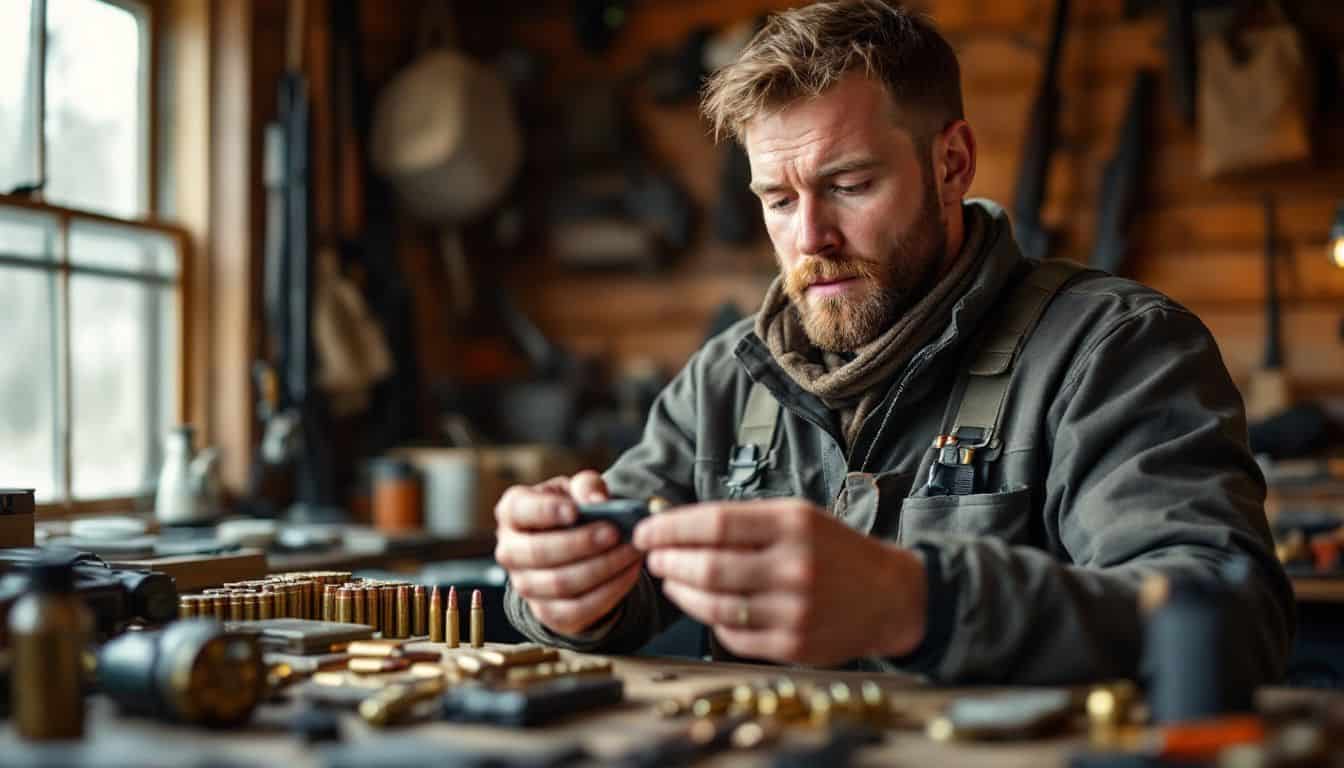
Picking the right caliber and ammo is key for hunting success. Smaller rounds like .243 Winchester work great for ducks and other small game. For bigger animals like elk, you’ll need more punch.
The .308 Winchester is a popular all-rounder. It comes in many bullet weights, making it good for different hunts. The 6.5mm Creedmoor is gaining fans too. Hunters love it for long-range shots and deer hunting.
Your choice depends on what you’re after. The .270 Winchester hits hard but doesn’t kick much. It’s perfect for medium-sized game. For a mix of power and ease, try the .243 Winchester.
It’s good for both target practice and hunting smaller deer. Next up, let’s talk about how to pick the best cartridge for your hunt.
Choosing the Right Hunting Cartridge
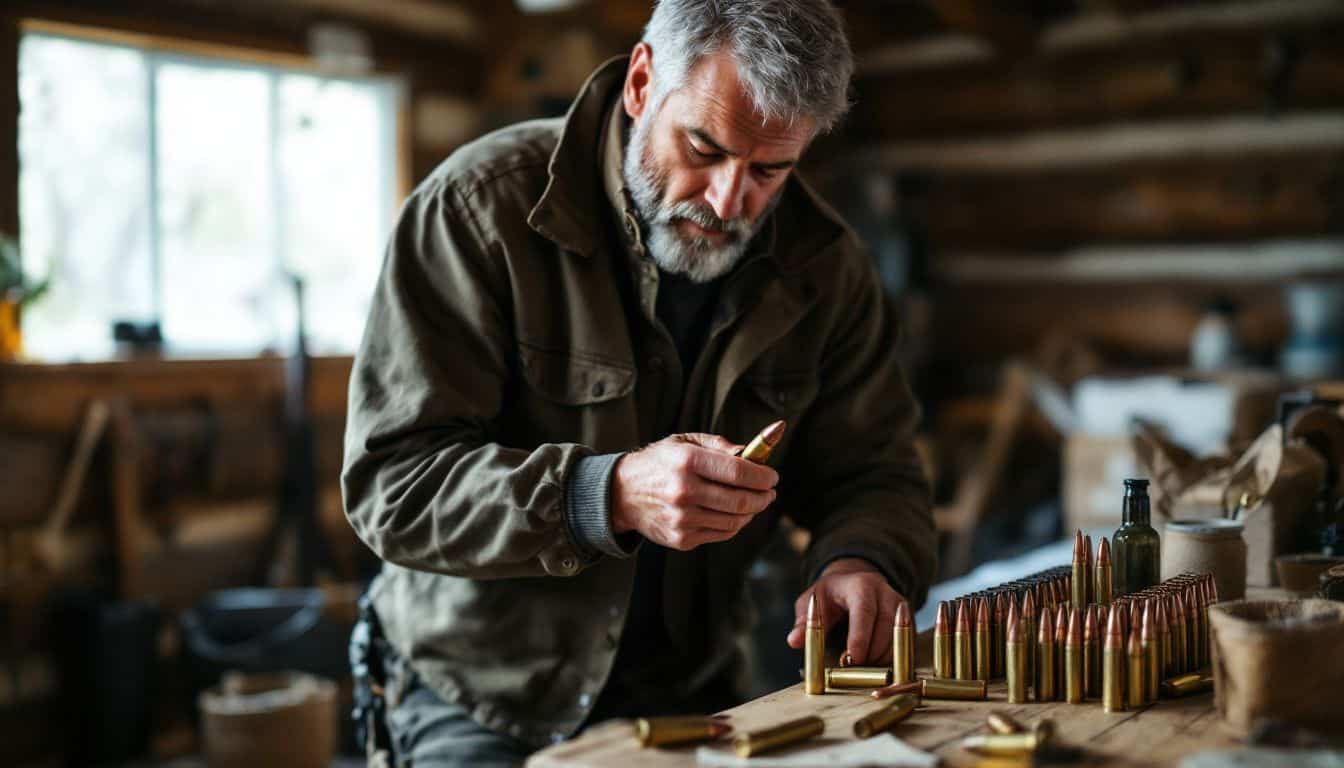
Picking the right ammo for your hunt is key. Your choice impacts how well you’ll take down game and how far you can shoot.
Game Size Considerations
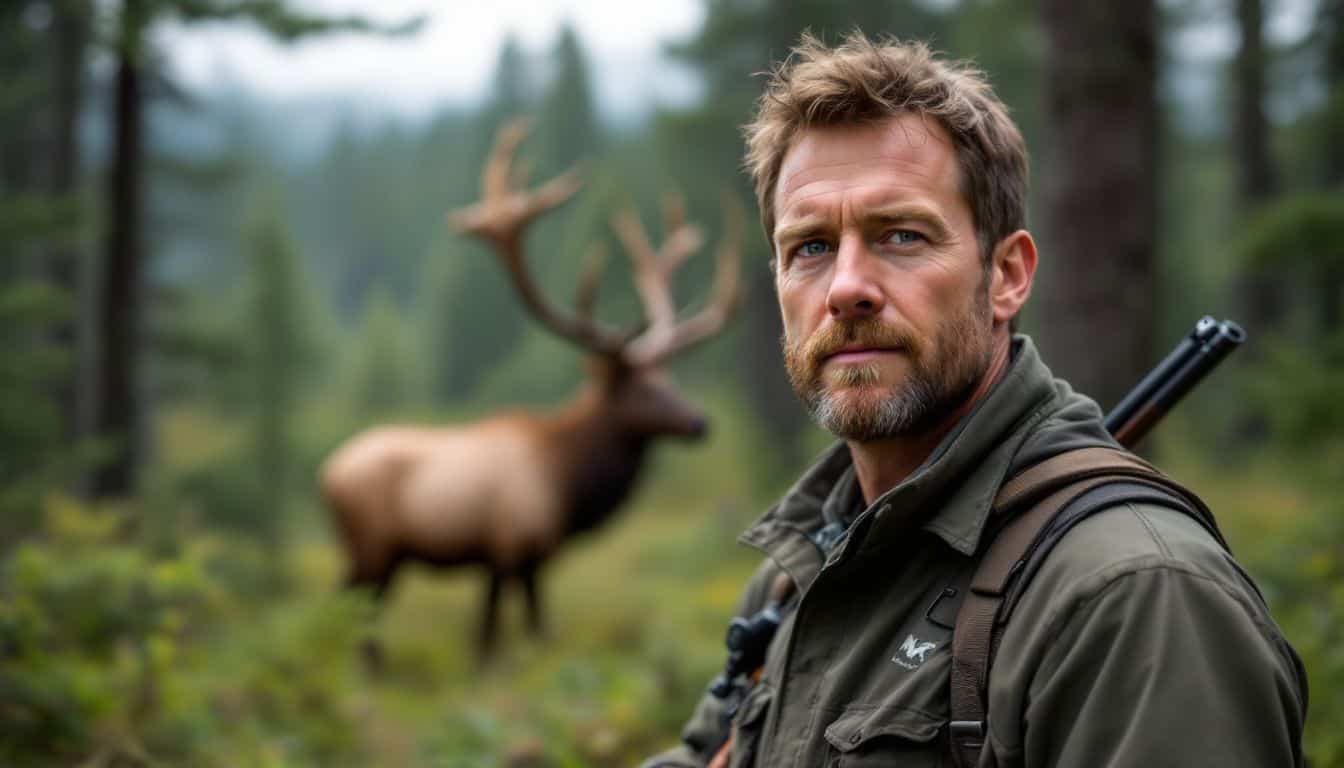
Game size matters when picking a hunting rifle. Bigger animals need more powerful cartridges. For deer and similar-sized game, the .270 Winchester or .30-06 Springfield work great.
They pack enough punch without too much kick. Smaller critters like coyotes or rabbits? A .243 Winchester fits the bill nicely. It’s accurate and won’t tear up the meat too much.
I learned this the hard way on my first elk hunt. My trusty deer rifle just didn’t cut it. The elk barely flinched at 200 yards! Since then, I’ve matched my guns to the game. It’s made hunting a much more excellent hobby.
For big game like elk or moose, go with something beefier. The .308 Winchester or 6.5mm Creedmoor are solid choices. They’ll drop those big boys with authority.
Range and Power Balance
Balancing range and power is key for hunting success. A rifle that packs a punch but can’t hit targets far away isn’t much use. The .270 Winchester hits this sweet spot. It’s got mild recoil, so you won’t flinch when firing.
But it still has enough oomph to take down big game at a distance. For new hunters, the .308 Winchester is a solid choice. It’s easy to handle and accurate at long ranges.
The right cartridge is like a good hunting partner – reliable, powerful, and always on target.
Power isn’t everything, though. The 7.62×39 Russian cartridge proves this point. It’s got less kick but still gets the job done. It’s accurate and won’t leave you sore after a long day in the field.
For those who want versatility, the .243 Winchester shines. It’s great for both small and big game. The 6.5mm Creedmoor is gaining fans too. It’s a champ at long-range shooting, making those far-off targets seem closer.
Types of Rifle Actions
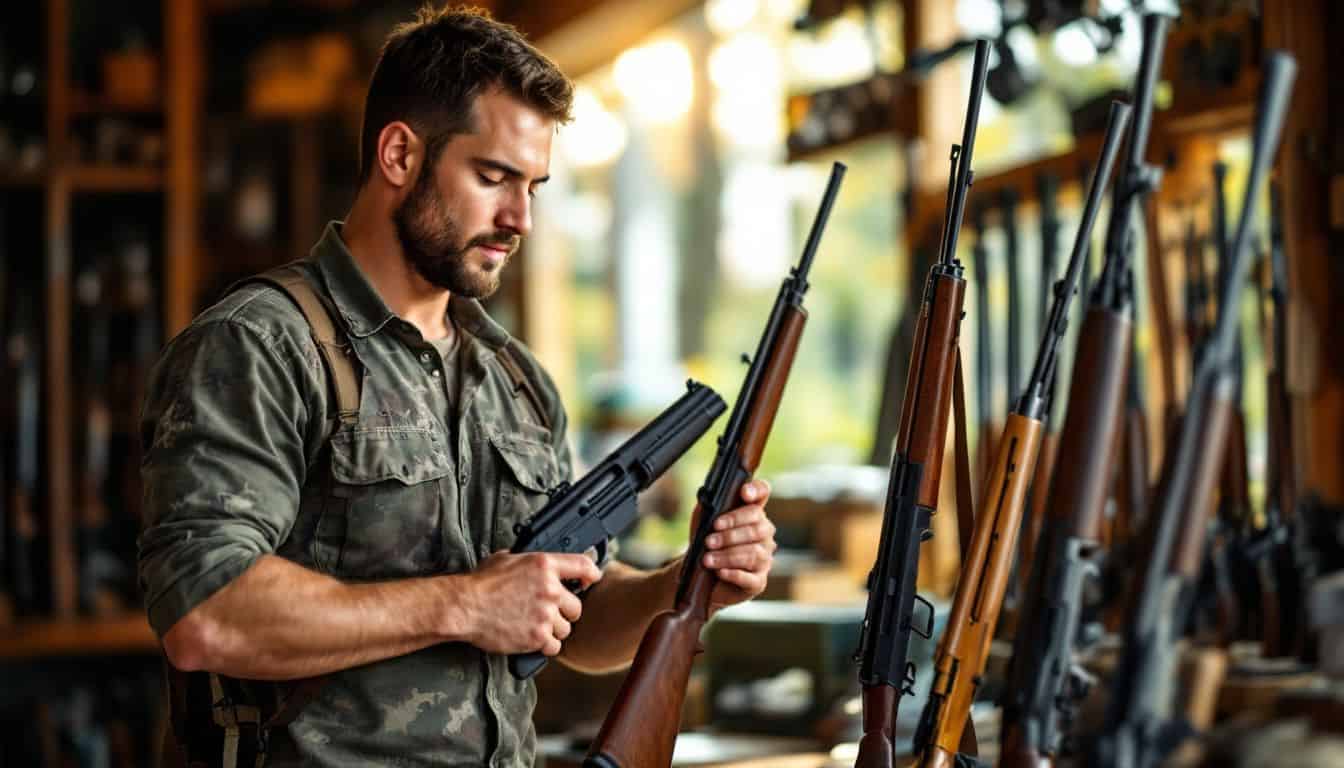
Rifle actions are central to your hunting weapon. They come in different styles, each with its own advantages. Let’s explore bolt-action, lever-action, and semi-automatic rifles – and see which one might suit you best.
Bolt-action Benefits
Bolt-action rifles are the best for hunting. They’re straightforward, durable, and extremely precise. These guns give you control over each shot. You load one round at a time, reducing the chance of issues.
Hunters prefer them because they perform well in all weather conditions.
Bolt-actions excel at long-range shots. They provide a stable foundation for high-quality scopes. This combination helps with distant targets. Also, they come in many calibers. This allows you to choose the right one for any game – from small animals to large bears.
Let’s compare lever-action rifles next.
Lever-action Mechanics
Moving from bolt-action to lever-action rifles, we see a shift in design and handling. Lever-action guns pack a punch in a compact package. Their short barrels and tight receivers make them perfect for quick shots in dense woods.
You’ll love how fast you can work the action – just push the lever down and forward to open it up.
A lever-action rifle is like a trusty old friend – always there when you need it.
These rifles have a cool, old-school vibe that many hunters dig. They’re not the top dogs in long-range shooting, but they hold their own at medium distances. The lever mechanism is simple yet effective.
It ejects the spent case and loads a fresh round in one smooth motion. This quick reload can be a game-changer when you need a fast follow-up shot.
Features of Semi-automatic Rifles
Semi-automatic rifles pack a punch for hunters. They let you fire fast and often. This makes them great for quick-moving game. You don’t have to work the action after each shot. The gun does it for you.
This means you can keep your eye on the target. It’s a big help when you’re after animals that move in groups.
These rifles excel in competitive hunting too. They’re easy to use and fit many needs. Some models can fire different types of ammo. This makes them handy for various hunts. The quick follow-up shots can be a lifesaver in tricky situations.
But keep in mind, practice is key to using them well. With the right skills, a semi-auto can be a top-notch hunting tool.
Ensuring Rifle Fit and Comfort
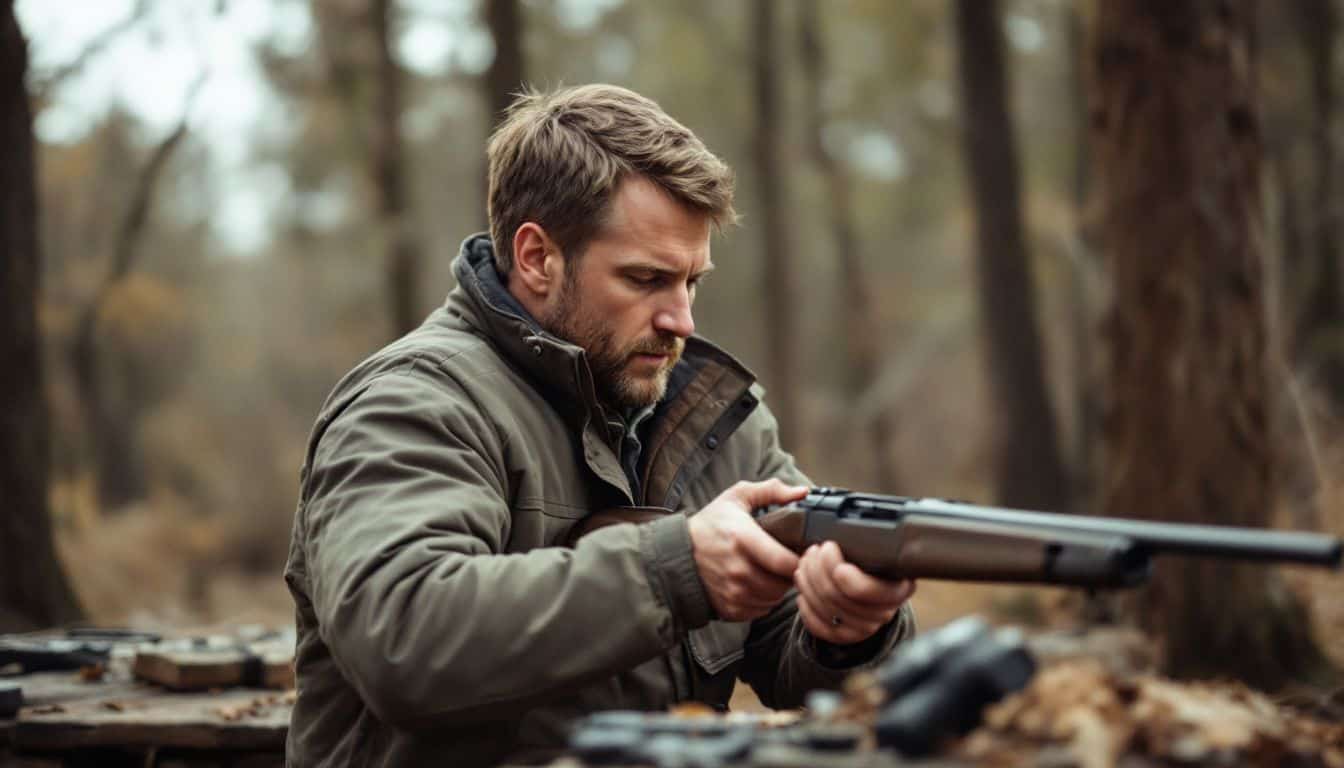
A rifle that fits you like a glove can make or break your hunt. It’s all about comfort and accuracy – and trust me, you’ll want both when you’re out in the field. Curious about how to nail that perfect fit? Keep reading!
Stock Options and Materials
Rifle stocks come in three main types: wood, laminate, and synthetic. Wood looks classic but can warp in wet weather. Laminate is tougher and more stable. Synthetic stocks are the most durable and weather-resistant option.
They’re also lighter, which helps reduce flinching when you shoot.
Your stock’s material affects how your rifle performs. Good bedding improves accuracy. Adjustable stocks let you customize the fit for comfort. Some plastic stocks need stabilizers to stay rigid.
Pick a stock that fits your needs and shooting style. The right choice will boost your confidence in the field.
Adjustability for Enhanced Accuracy
Adjustable features on a hunting rifle can make a big difference in your shooting. A good rifle fits you perfectly. It should feel natural when you bring it up to your shoulder. Many modern rifles come with adjustable parts.
These let you fine-tune the fit for your body and shooting style.
A well-adjusted rifle is like a custom-fit suit – it just fits right.
Key adjustments can improve your accuracy in the field. An adjustable cheek rest helps you align your eye with the scope. This gives you a clear view every time. Some rifles have triggers you can set as light as two pounds.
A light, crisp trigger makes it easier to shoot without jerking the gun. Bipods with adjustable height let you shoot from different positions. They also help control recoil, keeping you on target for follow-up shots.
Choosing Optics and Sighting Systems
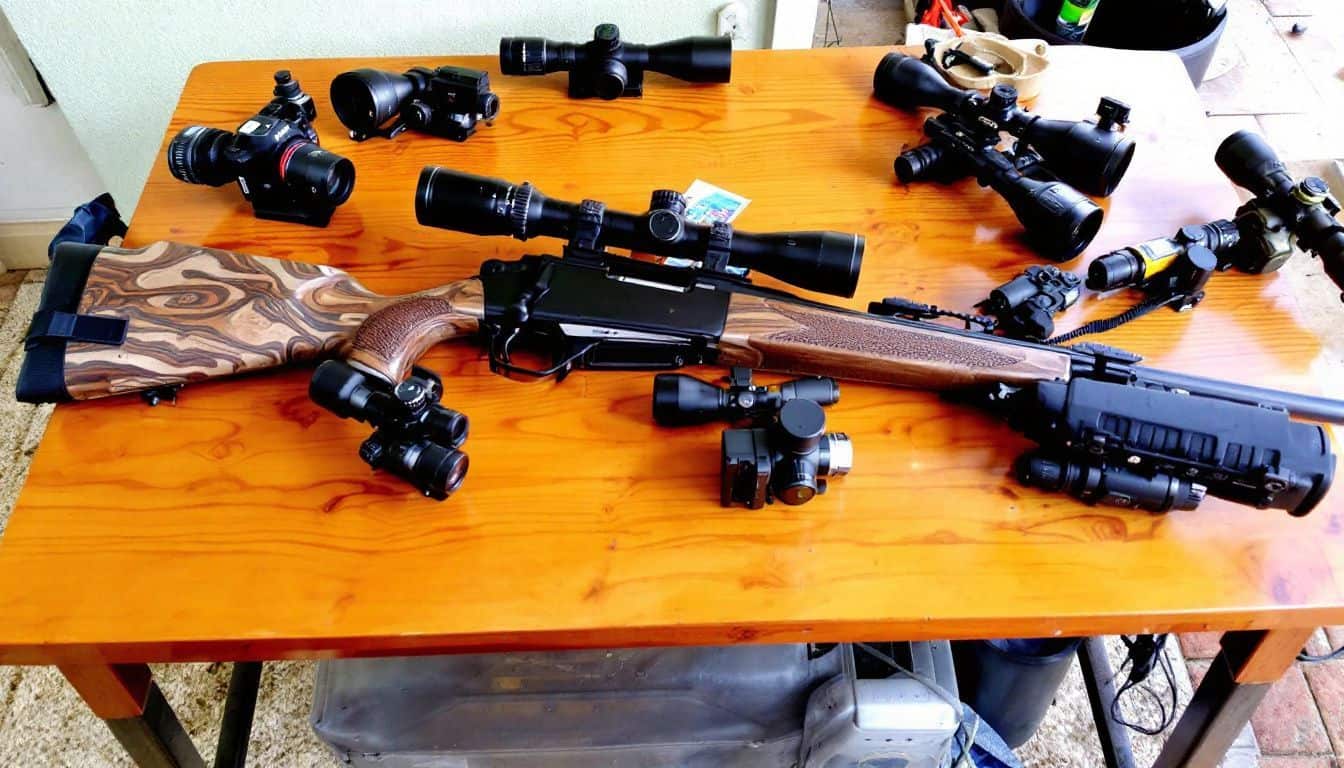
Picking the right sight for your rifle can make or break your hunt. Want to know how to choose the best optics for your needs? Keep reading!
Scope Selection
Choosing a scope can make or break your hunting experience. Let’s dive into some key points for picking the right one.
- Budget wisely: Quality scopes start at $500. Don’t skimp here – your aim depends on it.
- Magnification matters: For beginners, a 3-9x40mm scope with BDC reticle works well. It’s versatile for various hunting scenarios.
- Fixed vs. variable: Fixed magnification scopes shine in thick cover. They’re simple and tough.
- Light it up: Larger objective lenses let in more light. This helps in low-light conditions, like dawn or dusk hunts.
- Reticle options: Duplex, BDC, and MOA reticles each have their strengths. Pick one that fits your hunting style.
- Eye relief: This is the distance between your eye and the scope. More eye relief means less chance of scope bite.
- Durability: Look for waterproof and fog-proof scopes. They’ll stand up to rough weather and bumps.
- Brand reputation: According to Acme Hunting, a company that sells high-quality optics, trusted brands often deliver better performance and reliability.
Now that we’ve covered scopes, let’s look at the benefits of red dot sights.
Benefits of Red Dot Sights
Moving from scopes, let’s zero in on red dot sights. These nifty gadgets pack a punch for hunters. Red dot sights make aiming a breeze. They don’t magnify, so you won’t mess up your shot alignment.
Plus, you’ll spot your target faster – a big win when every second counts.
Red dot sights shine in other ways too. You can tweak the brightness to match your surroundings. Whether you’re in bright sun or dim woods, you’ll see clearly. They’re tough cookies too – built to take a beating and keep on ticking.
That’s why cops and soldiers love ’em. For hunters, it means better aim and quicker shots. It’s like having a secret weapon in your arsenal.
Using Iron Sights
Iron sights are old-school cool. They’re simple, tough, and never need batteries. I learned this firsthand hunting with my trusty Gevarm E1. The key? Focus on that front sight. It’s like magic for hitting your mark.
Peep sights are even better for lining things up. They help your eye naturally center the target.
Here’s a neat trick: try the “lollipop” method. Rest the front sight on your target like a candy on a stick. It works like a charm. And keep both eyes open. You’ll see more and shoot faster.
One last tip: a longer sight radius (distance between front and rear sights) ups your accuracy game. It’s all about making those shots count, fellas.
Legal Requirements for Hunting Rifles
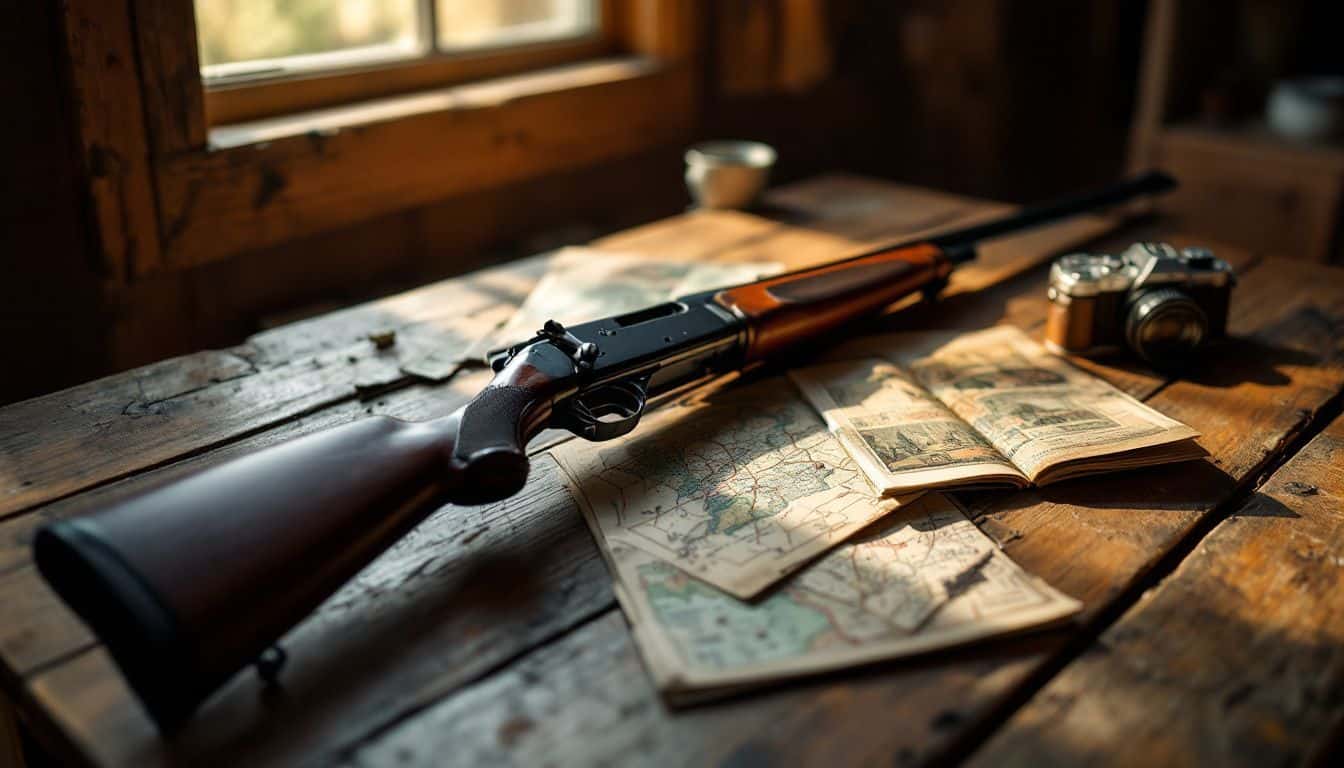
Buying a hunting rifle isn’t just about picking your favorite model. You’ll need to jump through some legal hoops first. Let’s dive into the rules you gotta follow before you can bag that buck.
Conducting Background Checks
Background checks are a must when buying a hunting rifle. Federal law says so. Since 1998, these checks happen through NICS. It’s a system that helps keep guns away from folks who shouldn’t have them.
You’ll fill out Form 4473 at the gun shop. This form asks for your info and helps track the sale.
Gun trafficking is a big problem. Almost half of illegal guns come from straw buyers. These are people who buy guns for others who can’t legally own them. To stop this, the law is strict about moving guns across state lines.
Only licensed dealers can do it. But there’s a catch. The law doesn’t cover private sellers. This means some sales happen without checks. It’s a gap that worries many people who want safer gun laws.
Understanding State Laws
After checking backgrounds, it’s time to dig into state laws. These rules can be tricky. They change from state to state. For example, in Minnesota, you must be over 18 to buy a rifle.
Some states have rules about bullet types too. Like using expanding point bullets for .24 caliber centerfire rifles.
Don’t assume all states are the same. Each one has its own set of rules. Some might surprise you. That’s why it’s smart to check local laws before buying. You don’t need a state permit to buy a rifle.
But you do need to fill out Form 4473 for a legal transfer. Always bring ID to prove your age. It’s a must for buying any gun.
Rifle Accessories and Maintenance
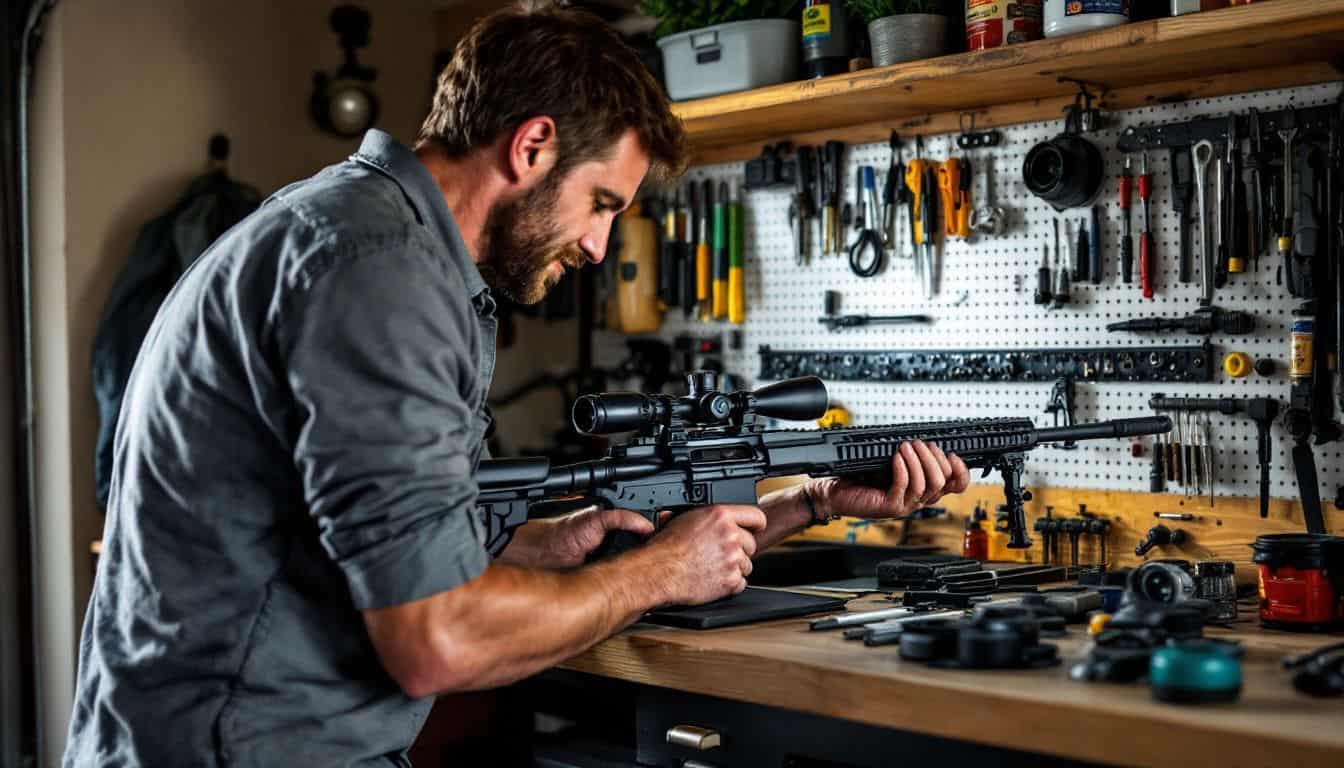
Your rifle needs more than just ammo. You’ll want to keep it clean and safe, too. Let’s talk about the must-haves for your hunting gun….
Essential Cleaning Supplies
Keeping your hunting rifle clean is crucial for its performance and longevity. Here’s a list of must-have cleaning supplies for your gun maintenance kit:
- Carbon fiber cleaning rod: This lightweight, durable rod won’t scratch your barrel.
- Jags: These attachments hold cleaning patches securely as you clean the bore.
- Bronze brushes: Use these to scrub away stubborn fouling in your rifle’s barrel.
- Cleaning chemicals: Stock up on solvents, degreasers, lubricants, and protectants.
- Gun utility brush: This tool helps you clean hard-to-reach nooks and crannies.
- Bore snake: Run this through your barrel to prevent build-up between deep cleans.
- Microfiber cloths: These soft, lint-free cloths are perfect for wiping down your rifle.
- Cleaning patches: Use these with your jags to remove dirt and apply chemicals.
- Gun oil: A light coat of oil protects your rifle from rust and keeps it running smooth.
- Cleaning mat: This padded surface protects your work area and catches small parts.
Choosing Protective Cases
Rifle cases are your gun’s best friend. They keep your firearm safe and sound during trips. Soft cases made of tough nylon or polyester work great for most hunters. They’re light and easy to carry.
Hard cases offer more protection but weigh more. Look for cases with lots of pockets. You’ll need space for ammo and other gear.
Picking the right size matters. Measure your rifle and add a few inches. This gives you room for scopes and other add-ons. Strong handles and straps make carrying easier. Good stitching keeps everything together.
Next up, let’s talk about bipods and slings – they’re game-changers in the field.
Selecting Bipods and Slings
After picking a good case, let’s talk about bipods and slings. These tools can make a big difference in your shooting. Bipods help keep your rifle steady. They come in different heights and can adjust to fit you.
Some have feet that work on various surfaces. Slings, on the other hand, make carrying your rifle easier. They also help you hold steady when shooting offhand.
I’ve used many bipods over the years. The best ones let you swivel and pivot. This helps when you’re hunting on uneven ground. For slings, I like ones that are comfy but tough. Leather or nylon works well.
Just make sure it fits your rifle and your body. With the right bipod and sling, you’ll shoot better and carry your rifle with less effort.
Purchasing a Hunting Rifle
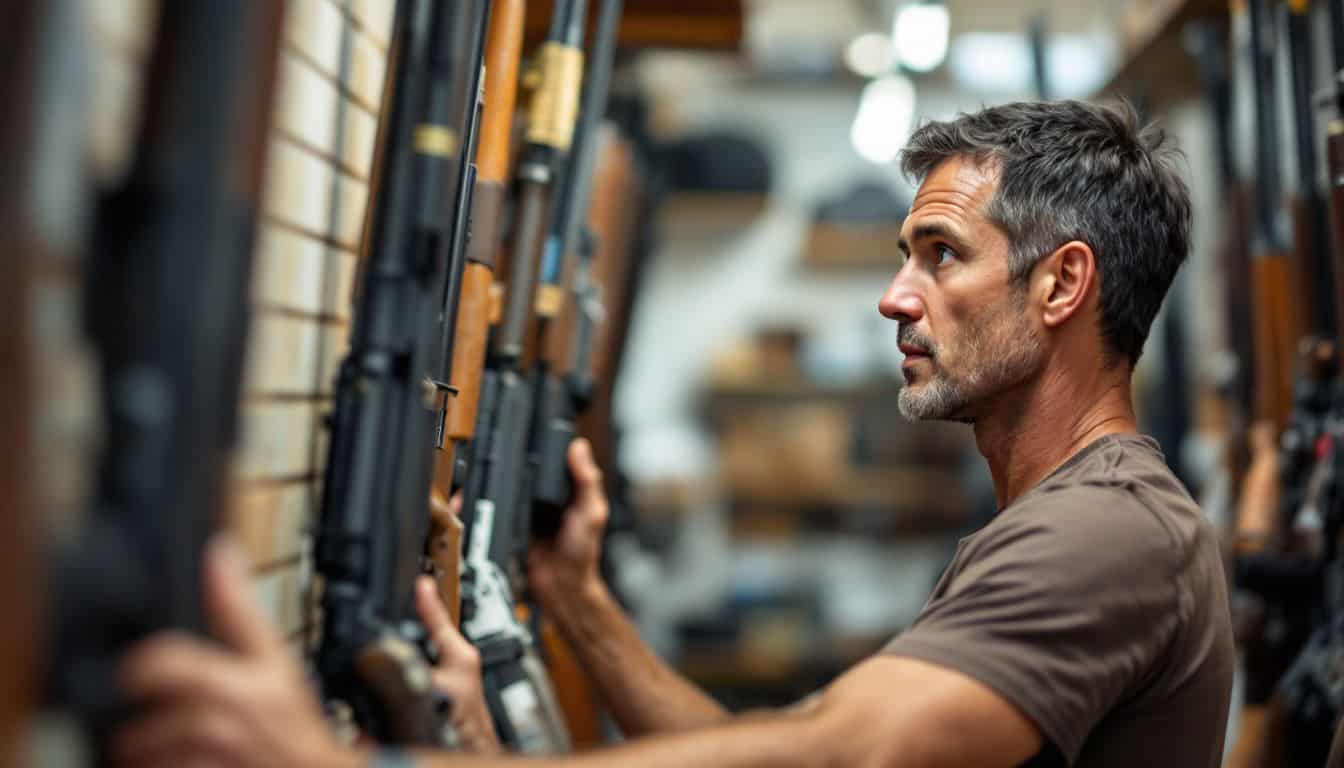
Ready to pull the trigger on your new hunting rifle? Let’s talk shop. Gun stores, online sellers, and even gun shows offer different perks – it’s like comparing apples, oranges, and…
well, rifles.
Comparing Gun Stores and Online Options
Let’s talk about where to snag that perfect hunting rifle. You’ve got two main options: local gun stores and online retailers. Each has its perks, so let’s break it down.
| Local Gun Stores | Online Retailers |
|---|---|
– Hands-on experience – Expert advice on the spot – No shipping hassles – Support local businesses – Prices $50-$150 higher than online | – Wider selection – Lower prices (avg. $800) – Shop from home – Easy price comparison – Possible demo rifles |
Key Considerations: – Price – Product condition – Quality assurance – Customer service | |
Online shopping’s a game-changer. Sites like guns.com offer solid deals. But hey, nothing beats holding that rifle before you buy. Local shops might cost more, but you’re paying for peace of mind. Plus, you’re supporting the little guy.
Here’s the kicker: online prices hover around $800. That’s a chunk of change less than most stores. But watch out for those demo rifles… they might’ve seen better days.
Bottom line? It’s your call. Want savings? Go online. Need that personal touch? Hit up your local shop. Either way, you’re on track to bag that perfect hunting rifle.
Attending Gun Shows and Private Sales
While online stores and gun shops offer convenience, gun shows and private sales provide unique opportunities. These venues allow for hands-on experience and direct negotiations. Here’s what you need to know:
- Gun shows: bustling events packed with firearms, gear, and fellow enthusiasts. You’ll find a wide range of rifles, from bolt-actions to lever-actions. Prices can be competitive, and you might snag a deal.
- Private sales: one-on-one transactions between gun owners. These often happen at shows or through local ads. You might find rare or vintage rifles this way.
- Age matters: you must be 18 or older to buy a rifle. Sellers will check your ID, so bring it along. No exceptions here – it’s the law.
- State laws vary: some places require background checks for private sales. Others don’t. Know your local rules before you go.
- Cash is king: many sellers at shows and private sales prefer cash. ATMs are usually on-site at gun shows, but bring enough to avoid multiple trips.
- Inspect before you buy: at shows, you can handle rifles and ask questions. In private sales, take your time to look over the gun. Don’t rush – a good seller will understand.
- Paperwork: even without a background check, it’s smart to get a bill of sale. This proves you bought the gun legally. It’s a simple step that could save headaches later.
- Networking: gun shows are great for meeting other hunters. You might pick up tips on local hunting spots or gear recommendations.
- Be ready to walk away: if a deal feels off, trust your gut. There are plenty of rifles out there. The right one will come along.
People Also Ask
What paperwork do I need to buy a hunting rifle?
You’ll need to fill out a Firearms Transaction Record. The gun shop will run your info through the National Instant Criminal Background Check System. This makes sure you’re not a felon or have a history of domestic violence.
Can I buy a hunting rifle if I have a criminal record?
It depends. Felons can’t own firearms. Neither can folks with domestic violence convictions. The Bureau of Alcohol, Tobacco, Firearms and Explosives has strict rules. Better check those before you shop.
What’s the difference between rimfire and centerfire rifles?
Rimfire rifles, like .22s, are great for small game and target practice. Centerfire rifles pack more punch for big game hunting. They use different firing mechanisms. Centerfire ammo is more powerful and pricier.
Should I choose a bolt-action or lever-action rifle?
Bolt-actions are super accurate. They’re top picks for long-range shooting. Lever-actions are faster for follow-up shots. They’re popular for brush hunting. It boils down to your hunting style and prey.
What about shotguns for hunting?
Shotguns are versatile. You’ve got options like pump-action, break-action, and semi-automatics. They’re great for bird hunting and close-range big game. Different choke tubes can change your shot pattern. Slugs turn them into deer-dropping machines.
How important is the scope when buying a hunting rifle?
A good scope is crucial. It helps you aim true. Look for quality glass with anti-reflective coating. Check the exit pupil size for low-light performance. A solid scope mount is a must. Don’t skimp here – your trophy buck will thank you.
References
- https://www.hunter-ed.com/national/studyGuide/Common-Actions-on-Rifles-and-Shotguns/201099_92829/
- https://thehuntingcompany.com/the-ultimate-guide-to-choosing-a-hunting-rifle/ (2024-06-19)
- https://www.fieldandstream.com/guns/traits-of-great-hunting-rifle
- https://hunter-ed.com/blog/how-to-choose-the-right-caliber/ (2024-04-11)
- https://www.themeateater.com/hunt/firearm-hunting/if-you-can-only-pick-one-big-game-hunting-cartridge-pick-this-one (2024-05-22)
- https://www.americanrifleman.org/content/the-beginner-deer-rifle-ar-versus-budget-bolt-action/ (2021-11-13)
- https://www.hunter-ed.com/national/studyGuide/Lever-Action/201099_92820/
- https://themarksmanindoorrange.com/different-types-of-rifle/
- https://www.ballisticstudies.com/Knowledgebase/Basic+Rifle+Accuracy+and+Ballistics.html
- https://www.rifleshootermag.com/editorial/8-ways-to-increase-rifle-accuracy/382983
- https://www.themeateater.com/hunt/firearm-hunting/ask-meateater-what-rifle-scope-should-i-choose (2019-07-19)
- https://udrange.com/the-advantages-of-using-a-red-dot-sight/
- https://www.youtube.com/watch?v=NrES31sVxes
- https://www.nzhuntingandshooting.co.nz/f32/using-iron-sights-53500/ (2019-08-25)
- https://www.craigboddington.com/hunting-tips/scopes-or-iron-sights
- https://www.nraila.org/get-the-facts/background-checks-nics/
- https://www.hunter-ed.com/wyoming/studyGuide/Legal-Firearms-for-Hunting-Big-Game-or-Trophy-Game-Animals/20105301_61530/
- https://www.triggersandbows.com/2018/03/26/7-gun-cleaning-essentials/ (2018-03-26)
- https://fs9tactical.com/blogs/news/features-to-look-for-in-a-tactical-rifle-case?srsltid=AfmBOooQVe1GPR2t66JM0Vq9f8vhFNh9lYEjiX-rcqQw14MWjG4vPNxx (2023-01-16)
- https://www.cvlife.com/blogs/news/how-to-choose-a-rifle-bipod?srsltid=AfmBOopJtOOj-zY8adBYwgwmdzxPDAWFGQShMhjt9QKBNTDSl7efMFL4 (2022-12-14)
- https://wooxstore.com/blogs/woox-journal/5-tips-to-find-the-best-rifle-bipod
- https://www.snipershide.com/shooting/threads/difference-in-quality-between-gun-sold-by-local-gun-store-vs-online.6930080/ (2019-02-25)
- https://www.nrablog.com/articles/2016/3/buying-and-selling-a-firearm-gun-shows (2016-03-25)
